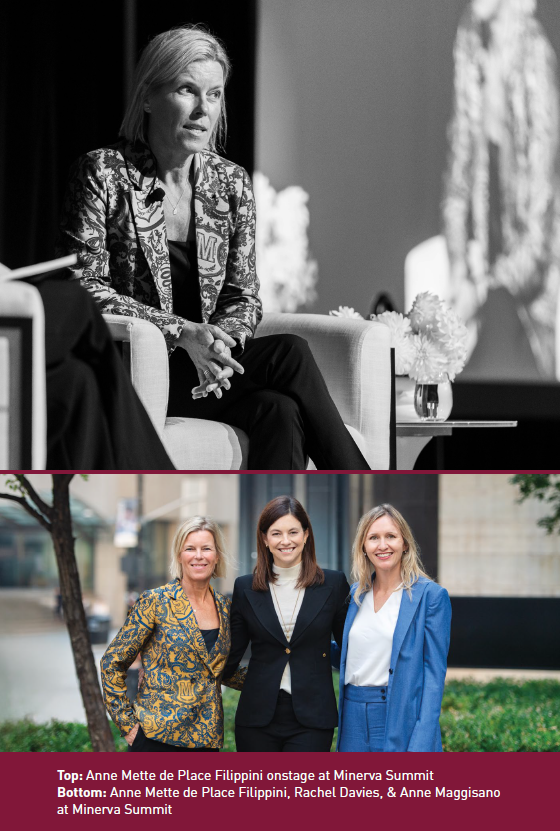Wealth transfer can be a formidable challenge, whether on an individual level, within a family dynamic, or from a business standpoint. Drawing from decades of research experience, Chief Investment Officer Anne Mette de Place Filippini has gained valuable insight into these complexities. At the Minerva Summit, she sat down with Investment Counsellor Kate Mostowyk to reflect on success stories, analyze failures, and explore strategies for entrepreneurs and wealth creators to establish enduring, multigenerational success for both their families and businesses. Here is their insightful conversation.
Kate Mostowyk: In our years of working with clients and analyzing business trends, we’ve often encountered a startling reality in wealth management: Despite best efforts, long-term stewardship of wealth frequently falls short of expectations. According to a PWC study, only 30 percent of wealth transfers between generations succeed, with a mere 5 percent of wealth surviving to the fourth generation.1 Anne Mette, why do you think this process is so difficult?
Anne Mette de Place Filippini: A fundamental challenge in business and wealth management is that longevity is hard. Most things do not last. Most businesses do not endure the test of time, highlighting the critical need for effective preparation and planning for transition, which are often overlooked areas.
We should also keep in mind the distinct skill sets required for building and operating a business—where wealth is often generated—versus those necessary for managing an investment portfolio. These differing competencies—creating wealth versus sustaining it—are crucial for long-term success.
The transition challenge takes on even greater significance considering recent trends. Studies indicate that 78 percent of private company owners in Canada are looking to sell or transition their businesses in the next few years. Such a significant shift in ownership represents a vital juncture for strategic business and wealth planning.
KM: You mentioned the difficulties in handing over a business to the next generation and the importance of planning. You’ve also dedicated many years to studying companies around the world, including in Mexico, India, China, and Brazil. Can you share an example with us?
AMDPF: I want to emphasize that we like to invest in entrepreneurial or family-owned businesses. We find there is a strong alignment of interests here because the businesses are run by people with skin in the game—they will have a drive and passion for the business. However, we are also acutely aware of the complexities surrounding transitions. A business arriving at such a complex transition raises a warning flag for us.
One example that comes to mind is Raia Drogasil, a company at which a near-failure situation played out. Today, it is a very successful fourth-generation family business and the largest publicly traded drug-store operator in Brazil. The founder ran the business for 50 years. However, not one of his seven children were actively involved in the company; instead, his four sons-in-law played a role. (He had five daughters, and in the ’40s and ’50s, it wasn’t customary for women to become involved in business.) When the founder died suddenly, there was no succession plan in place. The business floundered due to mismanagement and part-time efforts by three of the family members. In 1966, one of the sons-in-law secured a bank loan, bought out the other relatives, and began restructuring the business, leading to its eventual success.
Significant changes were implemented in 1980, including a new set of governing rules. One key rule was to prioritize the company over family interests. Another mandated that family members joining the business must have a top-tier education and prior work experience in other companies. This policy led to a blend of family and professional management up until the 2010s, with a family member serving as CEO. Now, a few family members remain involved, but the CEO is an external appointment. The family maintains its influence primarily through its role on the board of directors.

KM: What are some key considerations for us as investors when looking at founder-operated businesses as they prepare for succession?
AMDPF: Our approach in these situations is to look for a credible plan. If the business is still run by a first-generation founder who plans to hand over the reins, it’s crucial for us to assess the preparedness and capability of the next generation. Successful case studies often reveal well planned and gradual transitions—mentorship from the older generation starts early, and the younger generation’s shift to senior roles is incremental. This way, the next generation is allowed opportunities to learn and ultimately prove themselves along the way.
We’ve seen successful transitions where the next generation not only preserves the company’s culture and values, but also brings new perspectives and energy, leading to improved outcomes. Strategies may include buying out siblings or balancing the family’s need for liquidity with the business’s investment requirements. Sometimes, this balance is achieved by introducing new capital, either from private equity or public markets. Every situation is a little different and there is no one answer.
And if the next generation is to be primarily at the board level rather than in day-to-day operations, then the plan must involve professionalizing the management team.
“Successful case studies often reveal well planned and gradual transitions—mentorship from the older generation starts early, and the younger generation’s shift to senior roles is incremental. This way, the next generation is allowed opportunities to learn and ultimately prove themselves along the way.”
KM: The investment strategy for building wealth can be quite different from sustaining wealth. Can you discuss how these approaches differ?
AMPF: Yes, I’ll illustrate with an example. Last summer, I spent time with a client who had a successful career in the car-dealership industry and had built substantial wealth over time. He began with a single dealership, then expanded to several others throughout his career. Although he attempted to involve his children in the business, they were not interested and found his management style too strict. As he got older and no longer wanted to work as much, he started selling off the dealerships. He eventually sold out completely.
This transition marked a significant change for him. He went from running a business in an industry where he was an expert to handling a portfolio of liquid assets, something he neither knew how to run nor had any interest in managing. Ultimately, this client recognized he didn’t have the knowledge or desire to run the family’s investment portfolio. He sought advice and ended up hiring investment managers.
This situation underscores a couple challenges we often encounter. One is that our children may not share our passion for running the family business, making the transfer of management across generations a poor strategy for wealth preservation. The other is that the skills needed to successfully operate a company differ greatly from the skills—preserving and growing capital—that are required to invest well.
Significant family wealth is often created through successful ownership and growth of a business. It is a concentrated bet that is typically focused on a single business venture, requiring calculated risk taking, passion, and hard work.
Staying wealthy requires a different set of skills. It involves patience, strategic diversification, adhering to a long-term plan, and managing liquidity needs. Patience is particularly crucial, yet it’s a trait that is challenging to practice in an environment dominated by sensational headlines and market volatility. Private company owners are not faced with the daily repricing of their business. Learning to manage emotions during market volatility often presents a new and challenging skill to learn. Often the best strategy is to do nothing, which can feel counterintuitive to the nature of a hardworking entrepreneur who is accustomed to being involved and making decisions.
However, at the heart of wealth preservation and growth is the appreciation of the power of compound interest, which works best when it is not interrupted. To use an analogy, an asset is like a tree that needs many years to grow. And, in order to grow, the tree we plant must be robust enough to survive the inevitable storms—just as the companies we invest in need to be resilient and adaptable in times of challenge.
“The skills needed to successfully operate a company differ greatly from the skills—preserving and growing capital—that are required to invest well.”
KM: You mentioned that the power of compound interest is key to wealth preservation and growth. The theory of compounding is straightforward, yet it can be very hard to put into practice. Can you offer some guidance on this?
AMDPF: Getting rich slowly is an undervalued concept. Effective compounding isn’t about achieving a high return, it’s about maintaining returns over long periods of time. The hard part is that it requires patience because it can feel slow in the beginning when balances are smaller. It also requires us to control our emotions when volatility occurs. Compounding works best when returns are not interrupted.
We must also have realistic expectations for returns. My daughter, who is a client at Burgundy, recently asked me why her returns were not higher and mentioned that she wanted to take more risk to grow her portfolio more quickly. She also wondered if she should be owning alternative assets like cryptocurrencies and NFTs.
As a Burgundy client, she’s investing according to our quality/value investment philosophy, which entails buying great businesses at reasonable prices. We do not invest in companies that are in the early stages of development, in which the business model is not yet proven. Similarly, we do not own non-productive assets like cryptocurrencies, where there is no cash flow to estimate their worth. We consider this speculative investing, where emotions play a larger role and the probability of incurring significant losses is greater.
In my daughter’s case, we discussed how slight behavioural adjustments could enhance her long-term returns without dialing up risk. She has an income and saves regularly, which positions her well to benefit from dollar-cost averaging, initiating compounding earlier. Currently, her savings accumulate in a non-interest-bearing account and are transferred to her investment account only occasionally. In terms of increasing risk, I told her I’d prefer to see her do this during times of crisis—to be greedy when there is “blood in the streets” rather than succumbing to the fear of missing out during times of greed.
Over the long term, markets go up as businesses create value. A balanced approach involves being optimistic about the future while remaining vigilant about potential setbacks. Having the right temperament is crucial in striking this balance.
KM: To summarize our discussion, business transitions are indeed hard and require significant planning and preparation.
AMPF: Yes, that’s a fundamental lesson from the business world. Thoughtful and effective planning and preparation, along with continuous monitoring and assessment, are essential. Given the uncertainty of the future, it’s vital to consider different scenarios and it creates more resilience.
I also want to emphasize the distinction between acquiring wealth and maintaining it. There is a journey to wealth just as businesses have their own lifecycle: starting as an entrepreneurial, founder-led venture with a focused strategy, then often evolving into a more professionalized and sometimes diversified entity, each progressing at its own pace.
- PWC. “Once in a Lifetime: Moving Canadian Private and Family Businesses Forward.” 2019. https://www.pwc.com/ca/en/private-company-services/assets/pwc-canada-once-in-a-lifetime-report.pdf
This post is presented for illustrative and discussion purposes only. It is not intended to provide investment advice and does not consider unique objectives, constraints or financial needs. Under no circumstances does this post suggest that you should time the market in any way or make investment decisions based on the content. Select securities may be used as examples to illustrate Burgundy’s investment philosophy. Burgundy funds or portfolios may or may not hold such securities for the whole demonstrated period. Investors are advised that their investments are not guaranteed, their values change frequently and past performance may not be repeated. This post is not intended as an offer to invest in any investment strategy presented by Burgundy. The information contained in this post is the opinion of Burgundy Asset Management and/or its employees as of the date of the post and is subject to change without notice. Please refer to the Legal section of this website for additional information.

